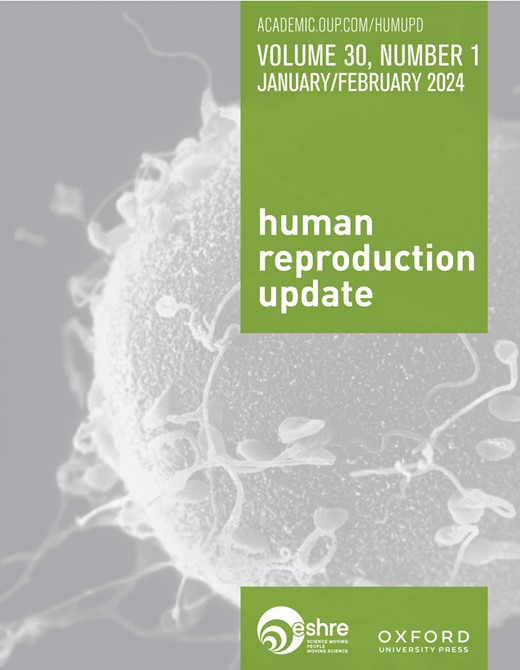妇女孕前生活方式干预——干预特征和行为改变技术的系统回顾和荟萃分析
IF 16.1
1区 医学
Q1 OBSTETRICS & GYNECOLOGY
引用次数: 0
摘要
背景:孕前是改善产妇生活方式,从而提高生育能力和健康水平的重要时机。然而,有效的孕前生活方式干预的组成部分尚不清楚。目的和理由本综述旨在评估干预特征和行为改变技术与生活方式干预对计划怀孕妇女生育、产科、胎儿、人体测量学和代谢结局的影响之间的关系。了解孕前生活方式干预的最佳组成部分对于提高未来干预的成功率至关重要。检索方法检索Ovid MEDLINE、PsycINFO、Embase、Emcare、Scopus、Cochrane Central Register of Controlled Trials和CINAHL(2024年12月6日)。我们纳入了计划怀孕妇女的随机对照试验,评估了生活方式干预与标准最低护理或不干预对生育、产科、胎儿、人体测量和代谢结果的影响。基于参与者特征、干预特征(使用干预描述和复制模板(TIDieR)框架)和行为改变技术(使用行为改变分类法v1),我们进行了随机效应荟萃分析和亚组分析。我们评估了可信度(使用随机对照试验(TRACT)清单中的可信度)、偏倚风险(使用Cochrane risk of bias 2.0工具)和证据的确定性(使用GRADE方法)。在资格筛选和可信度评估之后,我们纳入了24项研究(n = 7795名妇女),其中大多数在高收入国家进行(79%),研究了不孕妇女(67%)。7项研究的偏倚风险较低,15项研究的偏倚风险较高,2项研究的偏倚风险较高。总体而言,生活方式干预在临床妊娠(优势比[95% CI]: 1.06 [0.84, 1.35], I2 = 24.22%)或活产(优势比[95% CI]: 1.17 [0.82, 1.67], I2 = 48.73%)方面没有差异。干预超过10次(2.17 [1.21,3.86]vs 0.88[0.72, 1.07],亚组差异P = 0.004)和行为改变技术在环境中添加物体(例如提供符合干预要求的食物和/或运动器材)(3.51 [1.70,7.23]vs 0.90[0.75, 1.08],亚组差异P &;lt; 0.001)的临床妊娠几率更高。生活方式干预降低了体重(平均差异[95% CI]: - 3.87 kg [- 5.76, - 1.97], I2 = 95.03%)和空腹血糖(平均差异[95% CI]: - 0.15 mM [- 0.25, - 0.04], I2 = 0%)。以减肥为目标的干预措施的体重减轻幅度更大(- 4.19 kg [- 6.30, - 1.92] vs - 0.81 kg[- 1.48, - 0.14],亚组差异P = 0.003)。与面对面和技术相结合的干预(- 2.21 kg[- 3.62, - 0.81],亚组差异P = 0.02)相比,单独通过面对面提供的干预(- 6.02 kg[- 8.96, - 3.07])减少的体重更大。更广泛的意义旨在提高生育能力的孕前生活方式干预的有效性可以通过结构化、集约化的方法得到改善。孕前生活方式干预可以减轻体重,特别是以减肥为目的的面对面干预。然而,由于分析的探索性、纳入的研究数量有限以及研究水平亚组效应的潜在聚集偏倚,这些基于亚组分析的发现应谨慎解释,并值得进一步调查。未来孕前生活方式干预的干预特征选择应考虑患者偏好和实际考虑。本综述已在前瞻性系统评价注册(PROSPERO) (CRD42022333066)中前瞻性注册。本文章由计算机程序翻译,如有差异,请以英文原文为准。
Preconception lifestyle interventions for women—a systematic review and meta-analysis of intervention characteristics and behaviour change techniques
BACKGROUND The time before conception is an important opportunity to improve maternal lifestyle, and hence improve fertility and health. However, the components of effective preconception lifestyle interventions are unclear. OBJECTIVE AND RATIONALE This review aimed to assess the association of intervention characteristics and behaviour change techniques with the effect of lifestyle interventions on fertility, obstetric, foetal, anthropometric, and metabolic outcomes in women planning a pregnancy. Understanding the optimal components of preconception lifestyle interventions is essential to improve success of future interventions. SEARCH METHODS We searched Ovid MEDLINE, PsycINFO, Embase, Emcare, Scopus, Cochrane Central Register of Controlled Trials, and CINAHL (6 December 2024). We included randomized controlled trials on women planning a pregnancy which assessed the effect of lifestyle intervention compared to standard minimal care or no intervention on fertility, obstetric, foetal, anthropometric, and metabolic outcomes. We performed random-effects meta-analysis with subgroup analysis based on participant characteristics, intervention characteristics (using the Template for Intervention Description and Replication (TIDieR) framework), and behaviour change techniques (using the Behaviour Change Taxonomy v1). We assessed trustworthiness (using the Trustworthiness in Randomised Controlled Trials (TRACT) checklist), risk of bias (using the Cochrane Risk of Bias 2.0 tool), and certainty of the evidence (using the GRADE approach). OUTCOMES Following eligibility screening and trustworthiness assessments, we included 24 studies (n = 7795 women), of which the majority were conducted in high-income countries (79%) and studied women with infertility (67%). Risk of bias was low for seven studies, some concerns for 15 studies and high for two studies. Overall, there was no difference in clinical pregnancy (odds ratio [95% CI]: 1.06 [0.84, 1.35], I2 = 24.22%) or live birth (odds ratio [95% CI]: 1.17 [0.82, 1.67], I2 = 48.73%) with lifestyle intervention. Odds of clinical pregnancy were higher for interventions delivered over ≥10 sessions (2.17 [1.21, 3.86] vs 0.88 [0.72, 1.07], P = 0.004 for subgroup differences) and with the behaviour change technique Adding objects to the environment (e.g. provision of intervention-compliant food and/or exercise equipment) (3.51 [1.70, 7.23] vs 0.90 [0.75, 1.08], P < 0.001 for subgroup differences). Lifestyle interventions reduced weight (mean difference [95% CI]: −3.87 kg [−5.76, −1.97], I2 = 95.03%) and fasting blood glucose (mean difference [95% CI]: −0.15 mM [−0.25, −0.04], I2 = 0%). Greater weight loss was observed for interventions with a weight loss aim (−4.19 kg [−6.30, −1.92] vs −0.81 kg [−1.48, −0.14], P = 0.003 for subgroup differences). Greater weight loss was observed for interventions delivered solely via face-to-face (−6.02 kg [−8.96, −3.07]) compared to those delivered via a combination of face-to-face and technology (−2.21 kg [−3.62, −0.81], P = 0.02 for subgroup differences). WIDER IMPLICATIONS Effectiveness of preconception lifestyle interventions aiming to enhance fertility may be improved by a structured, intensive approach. Preconception lifestyle interventions reduce weight, particularly face-to-face interventions with a weight loss aim. However, these findings based on subgroup analyses should be interpreted with caution and warrant further investigation due to the exploratory nature of the analysis, limited number of studies included, and potential aggregation bias of study-level subgroup effects. Selection of intervention characteristics for future preconception lifestyle interventions should consider patient preferences and practical considerations. REGISTRATION This review was prospectively registered in the Prospective Register of Systematic Reviews (PROSPERO) (CRD42022333066).
求助全文
通过发布文献求助,成功后即可免费获取论文全文。
去求助
来源期刊

Human Reproduction Update
医学-妇产科学
CiteScore
28.80
自引率
1.50%
发文量
38
期刊介绍:
Human Reproduction Update is the leading journal in its field, boasting a Journal Impact FactorTM of 13.3 and ranked first in Obstetrics & Gynecology and Reproductive Biology (Source: Journal Citation ReportsTM from Clarivate, 2023). It specializes in publishing comprehensive and systematic review articles covering various aspects of human reproductive physiology and medicine.
The journal prioritizes basic, transitional, and clinical topics related to reproduction, encompassing areas such as andrology, embryology, infertility, gynaecology, pregnancy, reproductive endocrinology, reproductive epidemiology, reproductive genetics, reproductive immunology, and reproductive oncology. Human Reproduction Update is published on behalf of the European Society of Human Reproduction and Embryology (ESHRE), maintaining the highest scientific and editorial standards.
 求助内容:
求助内容: 应助结果提醒方式:
应助结果提醒方式:


